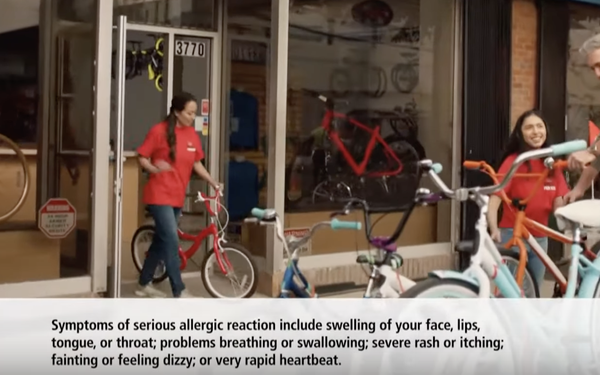
A few years ago, the FDA’s
Center for Drug Evaluation and Research (CDER) released eye-tracking research showing how a prescription drug commercial resulted in lower retention of its risk information when accompanied by
“distracting” visuals -- such as people engaged in recreational activities.
Prepare to say good-bye to such distractions.
By Nov. 20, all prescription drug ads in video and
audio formats must comply with the FDA’s new rule requiring that their “major statements” be presented in a “clear, conspicuous and neutral manner.” One major prohibition
is that ads “not include audio or visual elements, alone or in combination, that are likely to interfere with comprehension” of the major statement.
What exactly does that
mean?
To find out, we sat in on a recent webinar presented by Suzanna Boyle, an FDA regulatory counsel.
advertisement
advertisement
The “major statement,” we learned, is that part of a TV or radio ad,
usually at the end, that provides the drug’s major side effects and risks.
The new part of the rule concerns how to provide such info in that “clear, conspicuous and neutral
manner.”
Advertisers must apply five standards to accomplish that, according to Boyle.
1. Use “consumer-friendly language and terms that are readily
understandable.”
2. Make the ad’s audio information, in terms of volume, articulation, and pacing, “at least as understandable” as the audio information presented in
the rest of the ad.
3. As above, avoid “audio or visual elements…likely to interfere with comprehension of the major statement.”
4. For video ads, “the text
portion, size and style of font, contrast with the background, and placement on the screen” must allow the information to be read easily.
5. Also for video ads only, present the major
statement “concurrently using both audio and text.” This is called “dual modality.”
Achieving “dual modality” involves two requirements:
1. The text
must display either the key terms or phrases from the corresponding audio, or the complete transcript.
2. The text must be displayed “for a sufficient duration to allow it to be read
easily.” This duration, Boyle said,” is considered sufficient if the text display begins at the same time and ends at approximately the same time as the corresponding audio.”
Responding to audience comments that this would require TV ads to become longer, Boyle stressed the flexibility of using just key terms and phrases from the audio.
For example, instead of
displaying as text, “The most common side effects of Drug X are dry mouth, headache and heartburn,” the text could just read, “· dry mouth · headache ·
heartburn.”
Another audience member asked if the audio speed during the major statement needs to be identical to the audio speed in the rest of the ad.
No, answered Boyle, as
long as it’s as “understandable.”
And yet another question, we’d guess from a creative agency, asked, “Do we have to present the major statement without any
additional images in that part of the ad?”
“That's not our intent,” answered Boyle. “We know that sometimes multiple elements can be used to reinforce the presentation
of risk information. That's why we have the dual modality requirement. We get that.
“The standard, though, is meant to help ensure that there are no elements, whether audio, visual, or a
combination of those, that distract from the presentation of the risk information. It adds to the other standards to help ensure that consumers notice, attend to, and understand the major statement.
So there is no requirement that the major statement be presented without any additional images.”
The new FDA rule has been in the making for 17 years, was finally issued last Nov. 20,
and actually went into effect this May 20, although the FDA extended the compliance date for six months due to consideration of the “different stages of ad campaigns,” Boyle explained.
“We recognize that this rule could impact existing ads, as well as distribution agreements,” she said. ”So we believe that providing a compliance date of November 20, 2024,
enables firms to bring all ads that are subject to the rule into compliance, regardless of where those ads may be in their lifecycle.”
Our eyeballs will be watching.